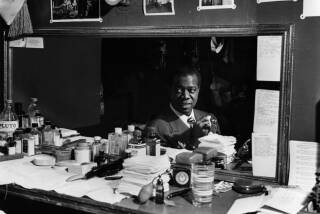Vacation Memories : It Was a Dark Night in Shanghai When We Encountered All That Jazz
- Share via
SHANGHAI, China — It had been a long, hard day ashore, what with the rail trip to Wuxi to visit the silk factory, the outing on the Grand Canal (which featured sampan gridlock) and the return trip to Shanghai, as our train parted the sea of commuter bicycles.
Bused back to our dock on the Huangpu River, most passengers on the Ocean Pearl were happy to repair to the ship’s lounges after the evening meal.
But I had heard about a jazz combo, a Chinese jazz combo, that played nightly at the Peace Hotel, a merger of the former luxury hotel Cathay and its neighbor the Palace, on the once-swank waterfront boulevard called the Bund.
My handy map of downtown Shanghai indicated that this establishment was just down the Huangpu from our dock, beyond Soochow Creek, which pours beneath Wai Bai Du Bridge into the big river.
So, after dinner, my wife and I, along with three other couples (someone overheard me saying the word “jazz” as we were heading for the gangplank and suddenly we were eight), disembarked into the sultry night.
A hundred yards or so into the blackness of the warehouse district, we turned left into Dong da Ming Lu, a river-paralleling thoroughfare illuminated only by a few street lights.
Unlike Japan and Hong Kong, the People’s Republic does not observe summertime, so it was dark at that hour, nearly 10 p.m. But the street was not deserted. No place in this most populous city (12 million) in the world’s most populous nation is ever deserted, I have decided.
Two or three couples of various ages passed us, in the opposite direction, on every block of the four or five we walked before we reached the brightness of the avenue that leads to the bridge and the Bund beyond.
Some were accompanied by children; one woman carried an infant. One couple sat on the curb and unpacked and repacked two shopping bags of what appeared to be hot takeout food. Under one streetlight a man worked on the detached rear wheel of a bicycle.
Every now and then an unlighted “cattle car” (the coinage was a shipmate’s), a municipal bus, would roar by, its windows filled. We could see the faces of the standees as it passed a streetlight.
(Virtually all passengers are standees who obliterate the occupants of the two rows of center-facing seats. When Shanghaiers say “mass transit,” they aren’t kidding.)
On the main drag, which Dong da Ming Lu joined a block or so before the bridge, the pedestrian traffic became a torrent. As we pushed across the span--neither with nor against the current, because people were walking in both directions on both of the pedestrian walkways flanking the vehicular lanes--we realized that these multitudes were abroad simply to socialize.
The phenomenon struck me as a late-night version of the evening paseo of Latin countries. Most pairs walked hand-in-hand or with arms around waists. Not infrequently the traffic flowed around couples locked in embrace, islands of passion in the mainstream. Beyond Soochow Creek, the crowd swirled and eddied into and out of river-side Huangpu Park.
Nary a soul spoke English, as we proved by repeatedly shouting “Peace Hotel?” into the maelstrom. Braving four lanes of bikes and buses, we cut across to the building side of what was obviously the Bund (although the only signs read Zhong Shan Dong Lu).
Two big buildings that I thought had to be the Peace Hotel proved to be offices of government agencies. Just as I started feeling misgivings, a young woman answered my shouts with “Peace Hotel? It’s there, up ahead.”
We thanked her and rounded the next corner. (Our group was now down to six, one couple having failed to navigate the human current.) In mid-block, two marquees--on opposite sides of the street--proclaimed “PEACE HOTEL.”
The building on the left, the old Cathay, showed no sign of life on its street floor. Inside the former Palace, across the street, a broad, dimly lit corridor, crisscrossed with subcorridors, ran through to the next street.
Just inside the entrance, a civilian who seemed to belong there answered our questions--”Jazz?” “Music?” “Dance?” (this to a mimed, Astaire-like two-step)--with a series of slight shrugs.
We walked by, peering down halls right and left. As we approached the last pair of halls before the far exit, we heard sounds from the left recess. We turned into it and saw light at the end of the tunnel. And as one, we recognized the sound. It was “A String of Pearls.”
Inside what proved to be a cavernous room, sight lines were better upward than across. The source of the light that washed tables, walls and white-tiled floor alike was high in the distant ceiling; the scene below was interrupted by a forest of columns, permitting a view of only three or four tables in a row in any direction.
The distinctly mature sextet, seated at floor level along the room’s long wall, was bouncing the Jerry Gray-Eddie De Lange standard off the columns, tiles and other hard surfaces, and holding its own against the din of conversation.
While the tenor sax was airborne in somewhat gingerly flight, in emulation of Lester Young, we seated ourselves at a couple of adjacent tables and proceeded to study the drinks list and our fellow music lovers.
The place was populated with all the types we had failed to encounter on our waterfront safari. Here at last was the cosmopolitan mix we had come to expect from movies about Shanghai.
A fatter, bearded Robert Morley-type in British officer shorts and fine leather walking boots smiled indulgently at his companion, a silk-bloused Oriental vision who wasn’t a day over 17.
A tanned Tom Selleck clone, in white shirt and pants, and his lady, an Occidental of a certain age in cashmere sweater and designer jeans, both wore running shoes.
There were several tuxedos in the house, one accompanied by patent-leather pumps, and a couple of floor-length gowns. And there was a chap with no shoes at all.
The combo rounded into the final, ensemble chorus of “A String of Pearls.” The drummer sounded steady, incisive, prompting one of our companions to compare him, jocularly and magnanimously, to Buddy Rich. When the band took a break, I approached the trumpeter bandleader.
“This is the band I read about in America, isn’t it?” I said.
He put down his instrument, flipped open a fat file folder and handed me the top item. There, in familiar format and typography, on a page lacking logo or page number, was a newsmagazine article on the band with a color closeup of him, Zhou Wan Rong, and his trumpet, and headlined “Shanghai’s Got Rhythm.”
The piece recounted Zhou’s long, disjointed love affair with American jazz. It told how he had heard the music on records before World War II, had assembled a small combo and had played for Americans during that war.
When the Yanks went home the band had split up. A couple of years ago, Zhou got to wondering whether he could round up his old sidemen. He found five, all, like himself, septuagenarians. “You’re famous!” I said. “You’re in Time magazine!” He nodded, beaming.
(On my return home, I was to find that Time had never heard of Zhou and neither had Newsweek. Nor had U.S. News & World Report, whose corresponding back-of-the-book section was identical in appearance to the other two.)
With his permission I took the tearsheet to our table and passed it around for my wife and our companions to look at.
As they read, Zhou turned to his next chart, nodded to his sidemen and swung into “You’d Be So Nice to Come Home To.”
The band--trumpet and sax alternating in the lead, backed by the piano--played the 1942 ballad straight and sweet, in the manner of the old “sweet bands.”
But about halfway through the first chorus, the chap who was not quite Buddy Rich became assertive again and provided a beat that was a slightly slower version of his “String of Pearls,” belting his snare drum and throwing in occasional rim shots that did not particularly enhance the tune’s sentimental mood.
What followed were several up-tempo numbers, a suitably slow “Autumn Leaves” and an even slower lament, which sounded like a funeral march, in China’s minor-key pentatonic scale.
A while later, when the group made its way to the door, I slipped the write-up back to Zhou, who smiled without missing a beat of his funeral march. As we headed down the dark corridor for the midnight walk back to the ship, the dirge ended and Not Quite Buddy Rich came back to life.
We walked into the evening to the distant beat of “When the Saints Go Marching In.”
More to Read
Sign up for The Wild
We’ll help you find the best places to hike, bike and run, as well as the perfect silent spots for meditation and yoga.
You may occasionally receive promotional content from the Los Angeles Times.






